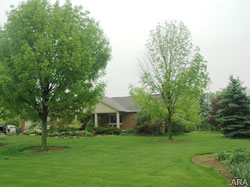
(ARA) – Virtually all of the 7 billion ash trees in the United States are at risk for infestation by the emerald ash borer, also known as EAB. You can save your ash trees by acting now and starting a prevention program.
The EAB is native to eastern Russia, northern China, Japan and Korea. In 2002, it was first discovered in southeast Michigan and Windsor, Ontario, likely a hitch-hiker in ash wood used for stabilizing cargo in ships, or for packing and crating. By May 2010, emerald ash borer infestations occurred in 12 states and two Canadian provinces.
By late spring 2010, the borer is estimated to have killed over 40 million ash trees in the United States and the potential devastation has been compared with the loss of the American elm and the American chestnut.
If you enjoy ash trees, have learned yours are infested, and are trying to save them from the emerald ash borer, it’s possible to take action and rescue your trees. Without treatment, it is only a matter of time before the insect attacks and eventually kills your ash trees. There are several options available to protect your trees, including doing it yourself or hiring a landscape specialist. Both options involve using a systemic insecticide that is applied to the soil or tree trunk or injected into the tree.
It is possible to protect ash trees before the borers attack a tree. These protective treatments are usually applied in the spring and should continue each year. Large trees may require two applications per year. Once the borer infests a tree, treatment costs increase, but the tree can be saved as long as the damage isn’t too severe or advanced.
The first step to protecting or treating infested trees is diagnosis. Contact a tree service company, a local nursery that offers this service, or a lawn and landscape service, such as Scotts LawnService. To find a service, a simple internet search of “emerald ash borer” within your zip code should give you companies that can provide EAB protection services. Make sure to ask if the technician who would provide the diagnostic and treatment services is licensed in your state.
Treatment options are generally less expensive than the cost of tree removal and replacement. For example, a 25- to 30-foot ash tree will cost about $400 to remove and replanting a similar size tree will cost about $2,000. In comparison, a landscape or tree company will charge about $50- to $75 per year to treat a tree that size, giving you about five to seven years of enjoyment before the cost of treatment equals the cost of tree removal.
“In my own yard, I have ash trees, several of which I value for shade and beauty,” says Lee Schaber, vice president of technical services for Scotts LawnService. “There are a few ash trees on the back lot line that are not as significant to me. I’ve treated the prized ashes for the past two seasons and left the other trees untreated.” Schaber continues, “The difference is remarkable: the treated trees look good, but the untreated trees are dying.” For more information on the emerald ash borer, go to www.emeraldashborer.info.
Courtesy of ARAcontent





